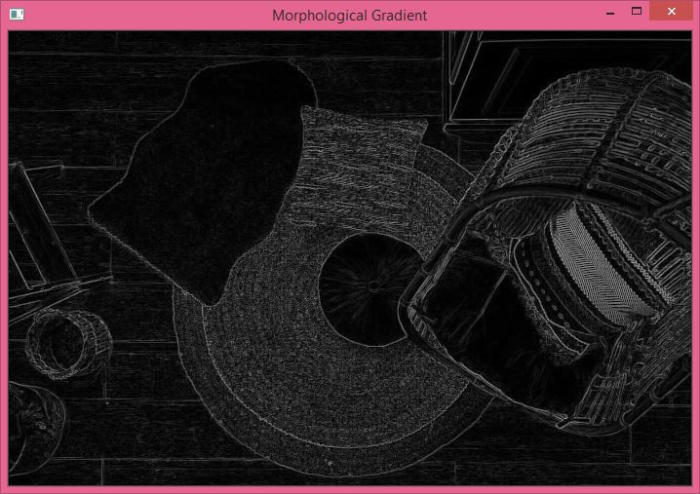
 Data Structure
Data Structure Networking
Networking RDBMS
RDBMS Operating System
Operating System Java
Java MS Excel
MS Excel iOS
iOS HTML
HTML CSS
CSS Android
Android Python
Python C Programming
C Programming C++
C++ C#
C# MongoDB
MongoDB MySQL
MySQL Javascript
Javascript PHP
PHP
- Selected Reading
- UPSC IAS Exams Notes
- Developer's Best Practices
- Questions and Answers
- Effective Resume Writing
- HR Interview Questions
- Computer Glossary
- Who is Who
How to compute the morphological gradient of an image using OpenCV in Python?
The morphological gradient is computed as the difference between the dilation and erosion of an image. We use cv2.morphologyEx() method to compute the morphological gradients. Morphological gradient is used in segmentation, edge detection and to find the outline of an object.
Syntax
Here is the syntax used for this method ?
cv2.morphologyEx(img, op, kernel)
Where,
img ? The original input image.
op ? Type of morphological operation. We use cv2.MORPH_GRADIENT.
kernel ? The kernel. We can define the kernel as a numpy matrix of all ones of dtye uint8.
Steps
You can use the following steps to compute the morphological gradients of an image ?
Import the required library. In all the following Python examples, the required Python library is OpenCV. Make sure you have already installed it.
import cv2
Read the input image using cv2.imread() as a grayscale image.
img = cv2.imread('floor.jpg', 0)
Compute the morphological gradient using cv2.morphologyEx(). Pass the kernel of desired size.
gradient = cv2.morphologyEx(img, cv2.MORPH_GRADIENT, kernel)
Display the gradient image using cv2.imshow() method.
cv2.imshow("Morphological Gradient", gradient)
cv2.waitKey()
cv2.destroyAllWindows()
Let's have a look at some examples for better understanding.
Example 1
In this Python example, we compute the morphological gradient of the input image using a 2Ã2 kernel.
# import required libraries import cv2 import numpy as np # read the input image img = cv2.imread('floor.jpg', 0) # define the kernel kernel = np.ones((2,2),np.uint8) # compute the morphological gradient gradient = cv2.morphologyEx(img, cv2.MORPH_GRADIENT, kernel) # display the gradient image cv2.imshow("Morphological Gradient", gradient) cv2.waitKey() cv2.destroyAllWindows()
We will use the following image as the Input File for this program.

Output
When you run the above Python program, it will produce the following output window ?

Example 2
In this example, we compute the morphological gradient of the input image using three different kernels? 2Ã2, 3Ã3 and 5Ã5 kernels.
import cv2 import numpy as np img = cv2.imread('tutorialspoint.png',0) kernel1 = np.ones((2,2),np.uint8) gradient1 = cv2.morphologyEx(img, cv2.MORPH_GRADIENT, kernel1) kernel2 = np.ones((3,3),np.uint8) gradient2 = cv2.morphologyEx(img, cv2.MORPH_GRADIENT, kernel2) kernel3 = np.ones((5,5),np.uint8) gradient3 = cv2.morphologyEx(img, cv2.MORPH_GRADIENT, kernel3) cv2.imshow("Morphological Gradient kernel= 2x2", gradient1) cv2.imshow("Morphological Gradient kernel= 3x3", gradient2) cv2.imshow("Morphological Gradient kernel= 5x5", gradient3) cv2.waitKey(0) cv2.destroyAllWindows()
We will use the following image as the Input File for this program ?

Output
When you execute the above program, it will produce three output windows. Three different windows correspond to the three different morphological gradient images using different kernel sizes. Notice the differences among the three outputs.


